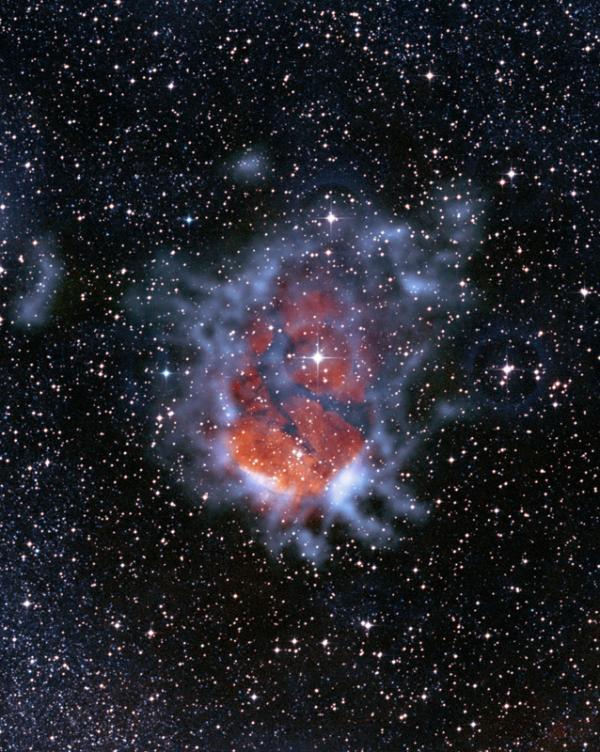Nursery star glowing
To illustrate the potential of submillimetre astronomical research astronomy (smaller than millimeters), an image of the APEX telescope reveals how an ionizing gas bubble lasts about 10 light years making objects The surrounding material turns into dense blocks, thus forming new stars. Submillimetre light is the key to understanding some of the coldest materials in the universe, such as dense and dense clouds.
The space, called RCW120, is about 4200 light-years from Earth , in the direction of the constellation Scorpius. A central star releases a large amount of ultraviolet radiation, ionizes the surrounding gas, expels electrons from oxygen atoms and produces red light called exothermic H-alpha.
When this ionization area expands in space, the accompanying shock waves create a layer of cold air and cosmic dust around. This layer vibrates and cracks under its own gravity into dense blocks, forming dense hydrogen clouds, where stars are born. However, because these clouds are very cold, with temperatures of around -250 degrees Celsius , the dim light emitted from the heat is only visible at submillimetre wavelengths. Submillimetre light is therefore important for studying the earliest stages of star formation.

The space, called RCW120, is about 4200 light-years from Earth, in the direction of the constellation Scorpius (Photo: ESO / APEX / DSS2 / SuperCosmos)
Submillimetre wavelength data is taken from the LABOCA camera on a 12-m APEX telescope, located at a 5000-meter plateau of Chajnator in Chile's Atacama desert. Thanks to LABOCA's high sensitivity, astronomers are able to detect concentrated air masses. Because the brightness of these blocks depends on their weight, this also means that astronomers can study the formation of smaller stars.
The Chajnator Plateau is also the place where ESO, along with its international partners, is building a new generation submillimetre telescope, ALMA. ALMA will use about 60 12-m antennas connected to each other over distances of more than 16 km , to form a giant telescope.
APEX is the result of a collaboration between Max-Planck Radio Astronomy Academy (MPIfR), Onsala Space Observatory (OSO), and ESO. The telescope is based on a prototype antenna built for the ALMA project. The operation of APEX at Chajnator is assigned to ESO.
- Giant stars are created from 'star nursery'.
- Travel to the 'star nursery' 160,000 light-years from Earth
- Thousands of years: Humanity is about to witness the formation of a new star
- Scientists see a star about to explode
- Sparkling colors of the nebula
- Discovering a strange ring around the super star Kappa Ori
- Pink nebula Omega
- Discovering the 'twin brothers' of the Sun, the prospect of the second Earth is no longer far away?
- Cherry blossom galaxies flourish, glowing mysterious pink light
- Why do stars have different brightness?
- 'Change gifts for sex' in insects
- Video: Travel to the 'star nursery' 1,500 light-years from Earth
 Van Allen's belt and evidence that the Apollo 11 mission to the Moon was myth
Van Allen's belt and evidence that the Apollo 11 mission to the Moon was myth The levels of civilization in the universe (Kardashev scale)
The levels of civilization in the universe (Kardashev scale) Today Mars, the sun and the Earth are aligned
Today Mars, the sun and the Earth are aligned The Amazon owner announced a secret plan to build a space base for thousands of people
The Amazon owner announced a secret plan to build a space base for thousands of people